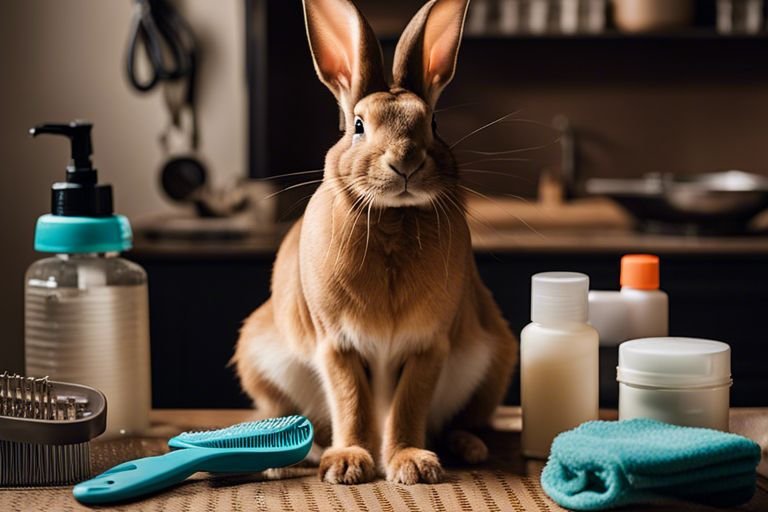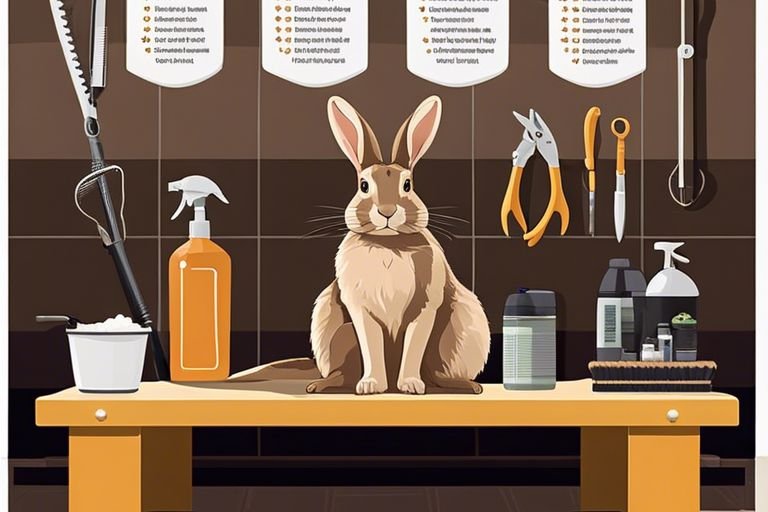After tending to the magnificent coat of your Flemish Giant, it is crucial to follow a strict hygiene regimen to ensure their well-being. Due to their large size and dense fur, grooming a Flemish Giant can be a time-consuming and intricate process. However, the post-grooming hygiene steps are equally significant to maintain their health and cleanliness. Failure to follow these steps could result in skin infections, matting, and discomfort for your beloved pet. In this blog post, we will outline the essential hygiene measures to take after grooming your Flemish Giant, so you can ensure their coat stays in prime condition and their health remains uncompromised.
Key Takeaways:
- Regular brushing: Regularly brush your Flemish Giant to remove loose fur and prevent matting. This will also help in distributing natural oils and keeping their coat in good condition.
- Cleaning ears: After grooming, inspect and clean your rabbit’s ears using a damp cloth. This helps in preventing ear infections and any build-up of dirt or wax.
- Nail trimming: Trim your rabbit’s nails to a suitable length. This should be done carefully to avoid cutting the quick and causing bleeding. Regular nail trims are essential for your rabbit’s comfort and health.
- Bathing: Flemish Giants do not require regular baths, but if they have soiled fur, you can use a mild rabbit-safe shampoo. Avoid getting water in their ears and take care to dry them properly afterwards to prevent skin issues.
- Checking skin: After grooming, check your rabbit’s skin for any signs of mites, dryness, or sores. Address any issues promptly and consult a veterinarian if necessary.

Post-Grooming Hygiene Steps for a Flemish Giant
If you have just finished grooming your Flemish Giant, it is essential to follow proper hygiene steps to maintain your rabbit’s health and well-being. Neglecting post-grooming hygiene can lead to infections, parasites, and other health issues. By implementing these hygiene steps, you can keep your Flemish Giant in optimal condition.
Cleaning Your Grooming Tools
Hygiene is of utmost importance when it comes to grooming your Flemish Giant. After each grooming session, it is crucial to thoroughly clean your grooming tools to prevent the spread of bacteria and parasites. Use a pet-safe disinfectant or a mixture of water and mild soap to clean your brushes, combs, and scissors. Make sure to remove any hair, dander, or debris from the tools to avoid contamination.
Sanitizing the Grooming Area
Grooming your Flemish Giant in a clean and sanitized environment is vital for their well-being. After each grooming session, thoroughly clean and sanitize the grooming area to prevent the spread of germs and bacteria. Use a pet-safe disinfectant to clean the grooming table or any surfaces where your rabbit was groomed. This will help eliminate any potential health hazards and keep your rabbit healthy and happy.
For instance, bacteria and parasites from previous grooming sessions can linger in the grooming area, potentially causing infections or skin irritations for your Flemish Giant. By regularly sanitizing the grooming area, you can minimize the risk of these health issues and create a safe environment for your rabbit.
Personal Hygiene After Grooming Your Rabbit
Even after grooming your beloved Flemish Giant rabbit, it’s essential to maintain proper personal hygiene to prevent the spread of bacteria and potential illnesses. This is especially important as rabbits can be carriers of harmful bacteria, and proper hygiene practices can help protect both you and your pet. For more information about bathing your pet rabbit, check out 3 Ways to Bathe Your Pet Rabbit.
Handwashing Techniques and Importance
Rabbit grooming involves close contact with your pet, which means thorough handwashing is a must after the grooming session. Use warm water and soap, and scrub your hands for at least 20 seconds to effectively remove any dirt, bacteria, or allergens. Proper handwashing is crucial to prevent the risk of contracting any illnesses and to maintain overall hygiene standards.
Protective Clothing and Gear Maintenance
Protective clothing, including gloves and aprons, can offer a barrier between you and your rabbit’s fur and potential allergens or bacteria. After every grooming session, it’s essential to properly clean and sanitize your protective gear to prevent the spread of any bacteria or allergens. Make sure to wash these items separately from your regular laundry, using hot water and a disinfectant detergent.
Your protective gear and clothing should be regularly inspected for any signs of wear and tear, as damaged gear may not provide the necessary protection. Ensure that your gloves and aprons are in good condition and replace them when needed to maintain proper hygiene standards for you and your rabbit. Regularly washing and inspecting your protective gear is essential for maintaining a safe and clean environment for both you and your pet.

Monitoring Your Flemish Giant Post-Grooming
To ensure the well-being of your Flemish Giant after grooming, it is important to closely monitor their behavior and physical condition. Regular monitoring can help you identify any potential health issues or signs of stress.
After your Flemish Giant’s grooming session, observe them for any abnormal behavior, such as excessive scratching, over-grooming, or changes in appetite. Check for any physical signs of discomfort, such as redness, swelling, or skin irritation. Regularly monitoring your Flemish Giant can help you address any grooming-related issues promptly.
Signs of Grooming-Related Stress or Health Issues
Flemish Giants may exhibit signs of stress or health issues after grooming, such as excessive licking or chewing of their fur, or avoidance of touch or handling. Other signs can include changes in their eating and drinking habits, as well as visible skin irritation or lesions. If you notice any of these signs, it is important to address them promptly to ensure the well-being of your Flemish Giant.
When to Seek Veterinary Care
Flemish Giant owners should seek veterinary care if they observe persistent signs of grooming-related stress or health issues, such as prolonged skin irritation, persistent changes in behavior, or any visible discomfort. Additionally, if there are any concerns regarding your Flemish Giant’s well-being after grooming, do not hesitate to consult a knowledgeable veterinarian for expert advice and care.
Monitoring your Flemish Giant post-grooming is essential for ensuring their well-being and addressing any grooming-related issues promptly. By closely observing their behavior and physical condition, you can identify signs of stress or health issues and seek veterinary care when necessary.
Conclusion
Hence, after grooming your Flemish Giant, it is important to take certain hygiene steps to ensure their health and well-being. This includes regularly checking their ears for wax and debris, brushing their coat to prevent matting and tangling, and trimming their nails to avoid overgrowth and discomfort. Additionally, it is crucial to clean their living space and provide them with fresh bedding to maintain a clean and sanitary environment. By following these hygiene steps, you can help keep your Flemish Giant happy and healthy.
FAQ: Grooming Your Flemish Giant
Q: How often should I groom my Flemish Giant?
A: It is recommended to groom your Flemish Giant at least once a week. Their dense fur can easily become tangled and matted, so regular grooming is important to prevent discomfort and skin issues.
Q: What hygiene steps should be taken after grooming my Flemish Giant?
A: After grooming your Flemish Giant, it’s important to check their ears for any signs of infection or excessive wax build-up. Additionally, ensure that their nails are trimmed to a proper length to prevent overgrowth and potential injury. Finally, brushing their teeth regularly will help maintain their dental health.
Q: How should I clean my Flemish Giant’s living area after grooming?
A: After grooming your Flemish Giant, it’s essential to clean their living area thoroughly. Remove any soiled bedding, droppings, and uneaten food. Wipe down the surfaces with a pet-safe disinfectant to prevent the build-up of bacteria and odors. It’s also important to regularly clean and replace their food and water dishes to maintain proper hygiene.
